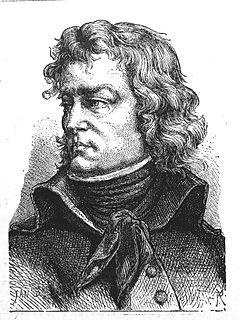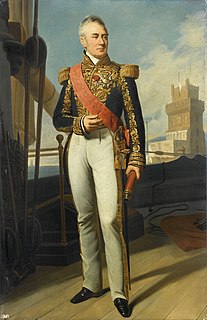 W
WBaron Augustin-Marie d'Aboville (1776–1843) was a French artillery officer during the French Revolutionary Wars and Napoleonic Wars, who rose to the rank of general of brigade. He was the son of General François-Marie d'Aboville (1730-1817) and younger brother of General Augustin Gabriel d'Aboville, both fellow artillery commanders.
 W
WBaron Louis Alméras was a French general. He distinguished himself under Napoleon in Italy and Egypt, and was taken prisoner by the Russians in the retreat from Moscow. Returning to France after Napoleon's fall, he was made chevalier of St. Louis in 1814. In 1823, governor of Bordeaux, where, prematurely old through hard service and wound, he died. He was a commander of the Order of Saint Louis.
 W
WBache-Elzéar-Alexandre d'Arbaud de Jouques (1720-1793) was a French aristocrat and public official. He served as the Governor of Guadeloupe from 1775 to 1782.
 W
WLouis-Alexandre Berthier, 1st Prince of Wagram, Sovereign Prince of Neuchâtel, was a Marshal of the Empire doubling as Minister of War and chief of staff to Napoleon. Born into a military family, he served in the French Army and survived suspicion of monarchism during the Reign of Terror, before a rapid rise in the ranks during the French Revolutionary Wars. Although a key supporter of the coup against the Directory that gave Napoleon supreme power, and present for his greatest victories, Berthier strongly opposed the progressive stretching of lines of communication during the Russian campaign. Allowed to retire by the restored Bourbon regime, he died of unnatural causes shortly before the Battle of Waterloo. Berthier's reputation as a superb operational organiser remains strong among current historians.
 W
WPierre de Ruel, marquis de Beurnonville was a French general during the French Revolutionary Wars and later a marshal of France and Deputy Grand Master of Grand Orient de France.
 W
WClaude François Bidal, marquis d'Asfeld was a French Marshal of France.
 W
WJean Baptiste Camille de Canclaux was a French army commander during the French Revolution and a Peer of France. He joined a cavalry regiment the French Royal Army in 1756 and fought at Minden in the Seven Years' War. He attained the rank of maréchal de camp in 1788 and lieutenant general in 1792. He commanded the Army of the Coasts of Brest from May until October 1793 fighting several actions during the War in the Vendée. Replaced for political reasons, he led the Army of the West in 1794–1795. He held interior posts during the rest of the French Revolutionary Wars and under the First French Empire of Napoleon.
 W
WJean-Marie Defrance (1771–1855) was a French General of the French Revolutionary Wars and the Napoleonic Wars. He was also a member of the Council of Five Hundred, and a teacher at the military school of Rebais, Champagne.
 W
WGuillaume Dode de la Brunerie was a Marshal of France. On February 12, 1812, he married the daughter of Marshal Pérignon, Agathe-Virginie.
 W
WRené Trouin, Sieur du Gué, usually called René Duguay-Trouin, was a famous Breton corsair of Saint-Malo. He had a brilliant privateering and naval career and eventually became "Lieutenant-General of the Naval Armies of the King", and a Commander in the Order of Saint-Louis. Ten ships of the French Navy were named in his honour.
 W
WGuy-Victor Duperré was a French naval officer and Admiral of France.
 W
WPierre-Antoine, comte Dupont de l'Étang was a French general of the French Revolutionary and Napoleonic Wars, as well as a political figure of the Bourbon Restoration.
 W
WLieutenant General Jean-Baptiste Vaquette de Gribeauval was a French artillery officer and engineer who revolutionized the French cannon, creating a new production system that allowed for lighter, more uniform guns without sacrificing range. His Gribeauval system superseded the de Vallière system. These guns proved essential to French military victories during the Napoleonic Wars. Gribeauval is credited as the earliest known advocate for the interchangeability of gun parts. He is thus one of the principal influences on the later development of interchangeable manufacture.
 W
WFrançois Nicolas Benoît, Baron Haxo was a French Army general and military engineer during the French Revolution and First Empire. Haxo became famous in the Siege of Antwerp in 1832. He is the nephew of revolution era General Nicolas Haxo of Étival-Clairefontaine and Saint-Dié-des-Vosges in Lorraine, France.
 W
WCharles Jean d'Hector, comte d'Hector was a French aristocrat and naval officer. Losing his father at a young age, he soon entered the French Navy, starting his service during the Seven Years' War, notably at the battle of Quiberon Bay. Following that battle he and the chevalier de Ternay saved part of the French fleet which had taken refuge in the Vilaine estuary. He was promoted to capitaine de vaisseau then squadron commander at the start of the American Revolutionary War. Put in command of Brest and its naval force, he assisted the Naval Minister maréchal de Castries in his plans to reform the fleet. He was visited at Brest by the future Tsar Nicholas I and his family and at Cherbourg on an inspection by Louis XVI of France.
 W
WPhilippe Higonet was a French General and politician. He was born on 5 May 1782 in Saint-Geniez-d'Olt (Aveyron) and died on 7 April 1862 in Aurillac (Cantal).
 W
WJean-Baptiste Mac Nemara, baron du Mung, seigneur de la Rochecourbon, Tourfou, Moullet et autres lieux was a French Navy officer of Irish origin.
 W
WGabriel-Jean-Joseph, 1er Comte Molitor, was a Marshal of France.
 W
WLieutenant-General Charles Nicolas Victor Oudinot, 2nd Duc de Reggio, the eldest son of Napoleon I's marshal Nicolas Oudinot and Charlotte Derlin, also made a military career.
 W
WLouis François Perrin, comte de Précy, was a French nobleman and soldier who lead royalist forces during the Siege of Lyon.
 W
WOlivier Macoux Rivaud de la Raffinière was a French infantry commander during the French Revolutionary and Napoleonic Wars.
 W
WAlbin Reine Roussin was a French admiral and statesman.
 W
WEdmond de Talleyrand-Périgord, 2nd Duke of Talleyrand, 2nd Duke of Dino, was a French general of the Napoleonic Wars.
 W
WAntoine Jean Marie Thévenard was a French politician and vice admiral. He served in the French ruling regimes of Louis XVI, those of the Revolution, Napoleon I and Louis XVIII, and is buried at the Panthéon de Paris. His son Antoine-René Thévenard, capitaine de vaisseau, was killed at the Battle of Aboukir whilst commanding the 74-gun Aquilon.
 W
WJean André Tiburce, viscount Sébastiani de La Porta, was a French general and politician. He was born on 21 March 1786 in La Porta (Haute-Corse) and died on 16 September 1871 in Bastia (Haute-Corse). Deputy of Corsica from 1828 to 1837, and Peer of France, he was the brother of the Marshal of France and politician Horace Sébastiani.
 W
WLouis Vallin was a French general. He was involved on the Royalist side in the French intervention in Spain. His name is inscribed in the 12th column on the Arc de Triomphe in Paris. He was a commander of the Order of Saint Louis and a grand officier of the Legion of Honor, as well as being made a baron under the First French Empire.